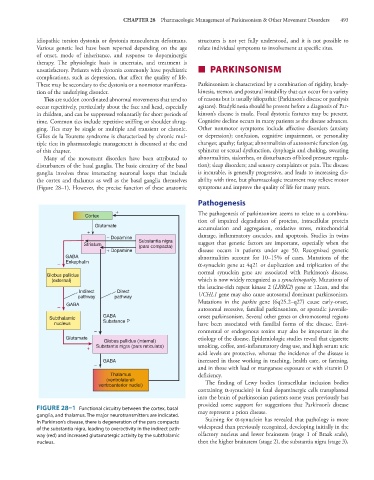Page 507 - Basic _ Clinical Pharmacology ( PDFDrive )
P. 507
CHAPTER 28 Pharmacologic Management of Parkinsonism & Other Movement Disorders 493
idiopathic torsion dystonia or dystonia musculorum deformans. structures is not yet fully understood, and it is not possible to
Various genetic loci have been reported depending on the age relate individual symptoms to involvement at specific sites.
of onset, mode of inheritance, and response to dopaminergic
therapy. The physiologic basis is uncertain, and treatment is
unsatisfactory. Patients with dystonia commonly have psychiatric ■ PARKINSONISM
complications, such as depression, that affect the quality of life.
These may be secondary to the dystonia or a nonmotor manifesta- Parkinsonism is characterized by a combination of rigidity, brady-
tion of the underlying disorder. kinesia, tremor, and postural instability that can occur for a variety
Tics are sudden coordinated abnormal movements that tend to of reasons but is usually idiopathic (Parkinson’s disease or paralysis
occur repetitively, particularly about the face and head, especially agitans). Bradykinesia should be present before a diagnosis of Par-
in children, and can be suppressed voluntarily for short periods of kinson’s disease is made. Focal dystonic features may be present.
time. Common tics include repetitive sniffing or shoulder shrug- Cognitive decline occurs in many patients as the disease advances.
ging. Tics may be single or multiple and transient or chronic. Other nonmotor symptoms include affective disorders (anxiety
Gilles de la Tourette syndrome is characterized by chronic mul- or depression); confusion, cognitive impairment, or personality
tiple tics; its pharmacologic management is discussed at the end changes; apathy; fatigue; abnormalities of autonomic function (eg,
of this chapter. sphincter or sexual dysfunction, dysphagia and choking, sweating
Many of the movement disorders have been attributed to abnormalities, sialorrhea, or disturbances of blood pressure regula-
disturbances of the basal ganglia. The basic circuitry of the basal tion); sleep disorders; and sensory complaints or pain. The disease
ganglia involves three interacting neuronal loops that include is incurable, is generally progressive, and leads to increasing dis-
the cortex and thalamus as well as the basal ganglia themselves ability with time, but pharmacologic treatment may relieve motor
(Figure 28–1). However, the precise function of these anatomic symptoms and improve the quality of life for many years.
Pathogenesis
+ The pathogenesis of parkinsonism seems to relate to a combina-
Cortex
tion of impaired degradation of proteins, intracellular protein
Glutamate accumulation and aggregation, oxidative stress, mitochondrial
+ damage, inflammatory cascades, and apoptosis. Studies in twins
– Dopamine
Striatum Substantia nigra suggest that genetic factors are important, especially when the
(pars compacta)
+ Dopamine disease occurs in patients under age 50. Recognized genetic
GABA abnormalities account for 10–15% of cases. Mutations of the
– Enkephalin α-synuclein gene at 4q21 or duplication and triplication of the
normal synuclein gene are associated with Parkinson’s disease,
Globus pallidus
(external) which is now widely recognized as a synucleinopathy. Mutations of
the leucine-rich repeat kinase 2 (LRRK2) gene at 12cen, and the
Indirect Direct UCHL1 gene may also cause autosomal dominant parkinsonism.
pathway pathway
GABA Mutations in the parkin gene (6q25.2–q27) cause early-onset,
– autosomal recessive, familial parkinsonism, or sporadic juvenile-
Subthalamic GABA onset parkinsonism. Several other genes or chromosomal regions
nucleus Substance P have been associated with familial forms of the disease. Envi-
– ronmental or endogenous toxins may also be important in the
Glutamate etiology of the disease. Epidemiologic studies reveal that cigarette
Globus pallidus (internal)
Substantia nigra (pars reticulata) smoking, coffee, anti-inflammatory drug use, and high serum uric
+
acid levels are protective, whereas the incidence of the disease is
GABA increased in those working in teaching, health care, or farming,
–
and in those with lead or manganese exposure or with vitamin D
Thalamus deficiency.
(ventrolateral- The finding of Lewy bodies (intracellular inclusion bodies
ventroanterior nuclei)
containing α-synuclein) in fetal dopaminergic cells transplanted
into the brain of parkinsonian patients some years previously has
provided some support for suggestions that Parkinson’s disease
FIGURE 28–1 Functional circuitry between the cortex, basal may represent a prion disease.
ganglia, and thalamus. The major neurotransmitters are indicated.
In Parkinson’s disease, there is degeneration of the pars compacta Staining for α-synuclein has revealed that pathology is more
of the substantia nigra, leading to overactivity in the indirect path- widespread than previously recognized, developing initially in the
way (red) and increased glutamatergic activity by the subthalamic olfactory nucleus and lower brainstem (stage 1 of Braak scale),
nucleus. then the higher brainstem (stage 2), the substantia nigra (stage 3),

